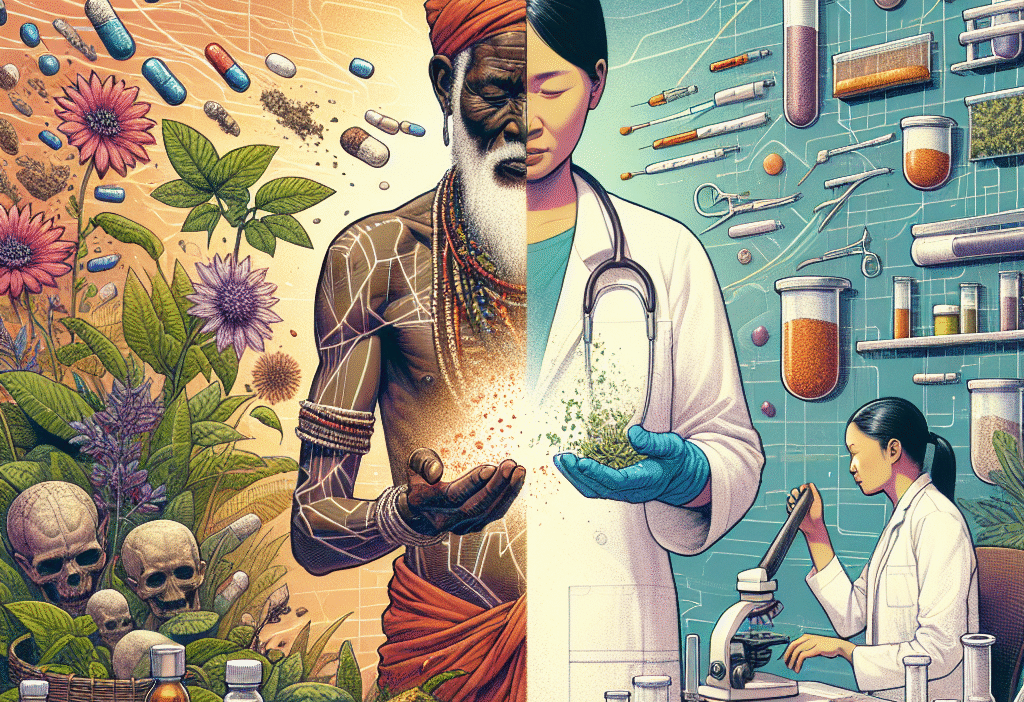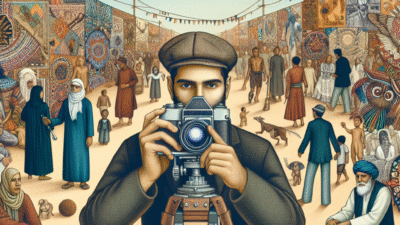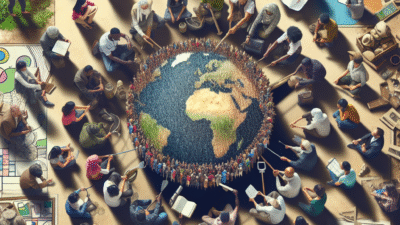Roots of Healing: Exploring the Intersection of Medical Anthropology and Traditional Healing Practices
Introduction
In a world increasingly dominated by modern medical advancements, the timeless wisdom of traditional healing practices remains more relevant than ever. Roots of Healing: Exploring the Intersection of Medical Anthropology and Traditional Healing Practices is a vital exploration into how these two fields can inform and enhance one another, ultimately leading us closer to a holistic model of health care. 🌍
The Importance of This Exploration
As we delve into this subject, we’ll uncover how medical anthropology helps us understand traditional healing systems, the cultural significance behind these practices, and the role they play in global health today. Readers will gain insights into the powerful synergy between modern medicine and traditional methods, offering a more comprehensive view of well-being.
Let’s embark on this enlightening journey together!
Understanding Medical Anthropology
What is Medical Anthropology?
Medical anthropology is an interdisciplinary field that combines the insights of anthropology and medicine. It studies how social, cultural, and economic factors impact health practices and beliefs. By exploring medical systems, including traditional healing practices, medical anthropology provides valuable context for understanding human health.
Key Elements of Medical Anthropology:
- Cultural Context: How cultural beliefs affect health perceptions.
- Social Structures: Understanding how societal roles impact access to care.
- Healing Practices: Investigating various methods of healing across cultures.
Why is Medical Anthropology Relevant?
In terms of the Roots of Healing, medical anthropology serves as a bridge between the contemporary healthcare system and traditional healing practices. This field helps elucidate how cultural perceptions of illness and wellness shape health behaviors and systems around the globe. It invites healthcare professionals to consider a broader spectrum of healing, ultimately benefiting patient care.
The Spectrum of Traditional Healing Practices
What Are Traditional Healing Practices?
Traditional healing practices encompass a variety of techniques used by indigenous communities around the world. These methods often include herbal remedies, spiritual healing, and other culturally-specific practices. The World Health Organization (WHO) recognizes these practices as integral components of global health systems.
Common Types of Traditional Healing Practices
| Type | Description | Regions |
|---|---|---|
| Herbal Medicine | The use of plants for medicinal purposes. | Global (various cultures) |
| Acupuncture | Insertion of needles at specific body points. | East Asia |
| Spiritual Healing | Methods that involve prayer, rituals, or faith-based practices. | Global |
| Massage Therapy | Physical manipulation of soft tissues. | Global (various cultures) |
Examples of Cultural Practices
- Ayurveda (India): A holistic system emphasizing balance among bodily systems through diet, herbal treatment, and yoga.
- Traditional Chinese Medicine (TCM): Incorporates acupuncture, herbal medicine, and tai chi, focusing on balancing the body’s energies.
- African Traditional Medicine: Often involves herbal treatments and the guidance of spiritual healers or shamans.
The diversity in traditional healing practices highlights the rich tapestry of human experience in addressing health and wellness.
The Intersection of Medical Anthropology and Traditional Healing
How Medical Anthropology Informs Traditional Healing Practices
At its core, medical anthropology seeks to understand the societal impact of health beliefs and practices. By studying these traditional healing methods, practitioners can glean insights into:
- Patient Hosts: Cultural perceptions of illness, which can improve communication and care.
- Community Engagement: Understanding local health narratives can foster better patient-provider relationships.
- Rituals and Healing: Identifying the significance of rituals can enhance the therapeutic effects of treatments.
Examples of Integration
- Culturally Adapted Care: Hospitals working with community healers to create treatment plans that respect traditional beliefs.
- Holistic Health Approaches: The growing trend of integrating yoga or massage therapy into conventional treatment plans.
Benefits of This Intersection
- Comprehensive Care: Addressing the emotional, spiritual, and physical components of health.
- Decreased Healthcare Disparities: Tailoring approaches to fit diverse populations.
- Increased Patient Satisfaction: Respecting cultural identities leads to improved outcomes.
Critical Insights into the Importance of Collaboration
A Case for a Holistic Approach
Research indicates that a holistic approach to health that incorporates both medical and traditional healing practices is more effective. For example, patients suffering from chronic illnesses have reported better outcomes when their treatments included cultural considerations and alternative therapies.
The Role of Trust Between Practitioners
Building trust between medical anthropologists, healthcare providers, and traditional healers is critical. Effective communication fosters collaboration that respects cultural practices while promoting scientific methodologies.
Case Study: Brazil’s Integrative Health System
In Brazil, the health system has incorporated traditional practices into public health. This model exemplifies how governmental recognition of herbal medicines and spiritual healing can lead to comprehensive healthcare solutions.
Challenges and Ethical Considerations
Navigating Colonialist Legacies
While promoting traditional healing practices, it is essential to be aware of any colonialist undertones in how these practices are studied or integrated. Cultural appropriation remains a significant issue, where the rich traditions of indigenous communities can be exploited for profit without proper acknowledgment or benefit to the communities themselves.
Balancing Efficacy and Safety
Integrating traditional and modern medical practices raises questions about efficacy, safety, and regulation. Continuous research and ethical oversight are required to ensure patient well-being while respecting cultural beliefs.
The Complexity of Informed Consent
The principle of informed consent must account for cultural ideologies surrounding knowledge and healing processes. Medical professionals must engage in ongoing dialogue with patients to respect their cultural frameworks while providing appropriate care.
Practical Applications of Integration
Steps for Health Professionals
- Cultural Competence Training: Implement training programs focusing on cultural sensitivity and understanding.
- Patient Involvement: Encourage patients to share their healing beliefs and practices, making them partners in their care.
- Multidisciplinary Health Teams: Foster teams that include medical professionals and traditional healers, promoting open communication.
Community Programs
Communities can establish health programs that integrate traditional healing methods alongside evidence-based practices, building bridges and enhancing health care delivery.
Conclusion
In summary, the Roots of Healing: Exploring the Intersection of Medical Anthropology and Traditional Healing Practices elucidates a significant yet often overlooked partnership in healthcare. By embracing this intersection, we can move toward more comprehensive and culturally competent health care solutions.
Motivational Insight
As we engage with these dual aspects of health, we empower not only ourselves but also our communities to redefine healing. Let’s celebrate the rich cultural heritage of traditional practices while advancing our understanding through medical anthropology. 🌱
FAQs
1. What is medical anthropology?
Medical anthropology is the study of how social, cultural, and economic factors influence health practices and beliefs. It helps us understand traditional healing systems and their significance in global health.
2. How do traditional healing practices differ from modern medicine?
Traditional healing practices often focus on holistic approaches that include emotional and spiritual aspects, while modern medicine typically emphasizes scientific research and evidence-based treatments.
3. Can integrating traditional healing practices improve healthcare outcomes?
Yes! Research indicates that incorporating traditional healing practices can lead to better patient satisfaction and improved health outcomes, especially in culturally diverse populations.
4. What challenges exist in integrating these two fields?
Challenges include navigating colonialist legacies, balancing efficacy and safety, and ensuring informed consent while respecting cultural practices.
5. How can healthcare professionals integrate traditional practices into modern medical settings?
Healthcare professionals can engage in cultural competence training, involve patients in their care, and foster multidisciplinary health teams that include traditional healers.
By exploring the dynamic interplay between medical anthropology and traditional healing practices, we open pathways for a more integrated, respectful, and effective approach to health care. Let’s embrace this journey of rediscovery and collaboration for improved health outcomes for all. 🌏✨




